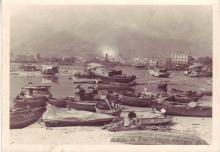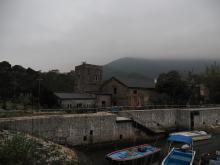[2024: I've updated the name of this Place from 'Chung Hau Old Mansion & Watch-tower'.]
The building is described in the AAB's Historic Building Appraisal number 244:
Yuen’s Mansion – West Watchtower, Chung Hau, Mui Wo, Lantau Island
Historical Interest
Chung Hau (涌口, literally, Mouth of a Stream) is one of the small villages in Mui Wo (梅窩), Lantau Island. Seven clans were deemed to be the earliest residents in Mui Wo. They are, namely, the Sus (蘇氏) and the Dus (杜氏) in Pak Ngan Heung (白銀鄉), the Gans (甘) in Luk Tei Tong (鹿地塘), the Tsuis (徐氏), Lams (林氏) and Wongs (黃氏) in Tai Tei Tong (大地塘), and the Wans (溫氏) in Chung Hau.
Yuen’s Mansion belongs to the Yuen family who were latecomers who first settled in Mui Wo in the 1920s. The Mansion was built in the 1920s–1940s by Yuen Wah-chiu (袁華照, 1888-1971). A native of Zengcheng in Guangdong province(廣東增城), Yuen Wah-chiu moved some of his family members to Mui Wo in the 1920s. At the time, the Yuen family raised livestock and grew rice and vegetables in a self-sufficient way, and sold the surplus in Cheung Chau (長洲). In the 1940s, Yuen Wah-chiu moved his whole family including wives, sons and 80 followers to Mui Wo for permanent settlement.
Yuen Wah-chiu was a high-ranking officer who served in the army of the Guomindang (國民黨, Chinese Nationalist Party). He joined with the guerrillas to fight against the Japanese along the Kowloon-Canton Railway in the late 1930s. He was the commander of the Sixth Commando (第六挺進縱隊) in Huizhou (惠州) in 1941. When people in Mui Wo were short of food supply during the Japanese Occupation (1941-1945), he released his stock of rice to the people in need and shipped food from the mainland. Due to his war efforts, he received a decoration from T.V Soong (宋子文), Finance Minister of the Nationalist Government (國民政府), for his braveness against the enemies. In 1953-63, he served as the chairman of Mui Wo Rural Committee (梅窩鄉事委 員會). He passed away in 1971, at the age of 83. The coffin was transported back to Mui Wo from Queen Elizabeth Hospital in Kowloon, and he was buried in Yuen’s farmland on Tiger Head Hill (虎頭山). One of his grandsons, Yuen Chit-chi (袁哲之), was a Councillor of Islands District Board in 1985-94.
Architectural Merit
The Yuen’s Mansion, which consists two watchtowers, a residential block and ancillary buildings, is a rare example of a comprehensive medium size old rural residential building group. It is sited beside Silver River (銀河) behind Silvermine Bay in Mui Wo, and enclosed with extensive fields linked to the hillside of Southern Lantau Island (嶼南路). Originally, the mansion used to be protected by a moat which has been removed now.
Natural granite courses are the major building material in the Yuen’s Mansion. The granite courses were laid on cement and sand mortar that forms all walls and columns. The houses were built merely to meet imperative accommodation needs therefore the building design and construction are simple. Ornamentation is minimal in this building group.
Two watchtowers were built in the east and west of the buildings. The two watchtowers are both two-storey high. The former is facing a fish pond and the latter is in the east of the front house. The West Watchtower is probably constructed of granite blocks and cement with its walls to support its flat roofs. Windows are on four sides of the tower and window hoods are on the external walls. A hood is made surrounding the parapet wall of the tower. The tower is plastered.
Rarity
This is a rare existing local example of a pair of watchtowers in the same village residence. These two watchtowers are two of four watchtowers in Mui Wo together with the one in Luk Tei Tong (曾氏), which is owned by the Tsang clan and the ruined one in Butterfly Hill (蝴蝶山) near Pak Ngan Heung (白銀 鄉).
Built Heritage Value
It has some built heritage value.
Authenticity
It was converted to residential use by alterations and addition works a long time ago.
Social Value, & Local Interest
The Yuen’s Manson is still owned and occupied by the original family, the Yuen family. It has local interest to the inhabitants round about.
Group Value
Together with the old buildings in nearby villages of Pak Ngan Heung (白銀鄉), Luk Tei Tong (鹿地塘) and Tai Tei Tong (大地塘), it bears witness to the historical development of Mui Wo.


